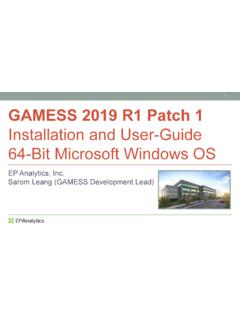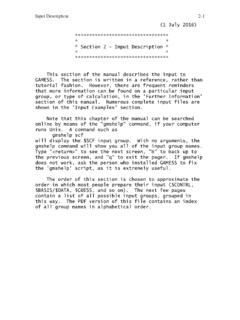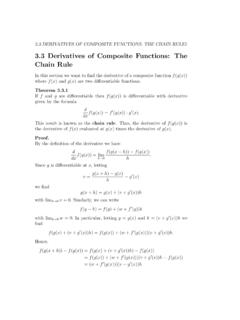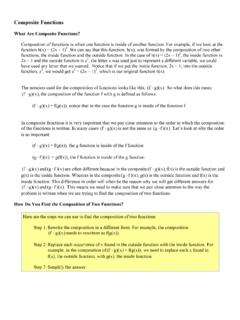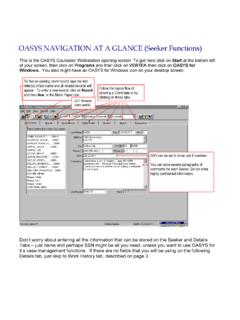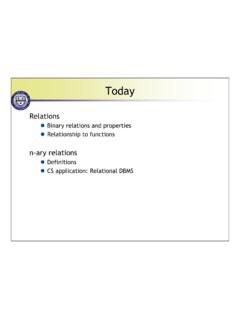Transcription of Input Description 2-1 - Gordon Group/GAMESS …
1 Input Description 2-1 (1 July 2016) ** * * * Section 2 - Input Description * * * ** This section of the manual describes the Input to GAMESS. The section is written in a reference, rather than tutorial fashion. However, there are frequent reminders that more information can be found on a particular Input group, or type of calculation, in the 'Further Information' section of this manual. Numerous complete Input files are shown in the ' Input Examples' section. Note that this chapter of the manual can be searched online by means of the "gmshelp" command, if your computer runs Unix. A command such as gmshelp scf will display the $SCF Input group. With no arguments, the gmshelp command will show you all of the Input group names.
2 Type "<return>" to see the next screen, "b" to back up to the previous screen, and "q" to exit the pager. If gmshelp does not work, ask the person who installed GAMESS to fix the 'gmshelp' script, as it is extremely useful. The order of this section is chosen to approximate the order in which most people prepare their Input ($CONTRL, $BASIS/$DATA, $GUESS, and so on). The next few pages contain a list of all possible Input groups, grouped in this way. The PDF version of this file contains an index of all group names in alphabetical order. Input Description 2-2 * name function module:routine ---- -------- -------------- Molecule, basis set, wavefunction specification: $CONTRL chemical control data INPUTA:START $SYSTEM computer related options INPUTA:START $BASIS basis set INPUTB:BASISS $DATA molecule, geometry, basis set INPUTB:MOLE $ZMAT internal coordinates ZMATRX:ZMATIN $LIBE linear bend coordinates ZMATRX:LIBE $SCF HF-SCF wavefunction control SCFLIB:SCFIN $SCFMI SCF-MI Input control data SCFMI :MIINP $DFT density functional theory DFT :DFTINP $TDDFT time-dependent DFT TDDFT :TDDINP $CIS singly excited CI CISGRD.
3 CISINP $CISVEC vectors for CIS CISGRD:CISVRD $MP2 2nd order Moller-Plesset MP2 :MP2 INP $RIMP2 resolution of the identity MP2 RIMP2 :RIDRVR $AUXBAS RI-MP2's basis set specification RIMP2 :RIDRVR $CCINP coupled cluster Input CCSDT :CCINP $EOMINP equation of motion CC EOMCC :EOMINP $MOPAC semi-empirical specification MPCMOL:MOLDAT $GUESS initial orbital selection GUESS :GUESMO $VEC orbitals (formatted) GUESS :READMO $MOFRZ freezes MOs during SCF runs EFPCOV:MFRZIN $DFTB DFTB Input DFTBLB: Input $DFTBSK Slater-Koster table Input DFTBSK:SKTAB Note that MCSCF and CI Input is listed below. Potential energy surface options: $STATPT geometry search control STATPT:SETSIG $TRUDGE nongradient optimization TRUDGE:TRUINP $TRURST restart data for TRUDGE TRUDGE:TRUDGX $FORCE hessian, normal coordinates HESS :HESSX $CPHF coupled-Hartree-Fock options CPHF :CPINP $CPMCHF coupled-MR-Hartree-Fock options MCPCGX:MCPCGX $MASS isotope selection VIBANL:RAMS $HESS force constant matrix (formatted) HESS :FCMIN $GRAD gradient vector (formatted) HESS :EGIN $DIPDR dipole deriv.
4 Matrix (formatted) HESS :DDMIN $ALPDR alpha polar. der. (formatted) RAMAN :ADMIN $VIB HESSIAN restart data (formatted) HESS :HSSNUM $VIB2 num GRAD/HESS restart (formatted) HESS :HSSFUL $VSCF vibrational anharmonicity VSCF :VSCFIN $VIBSCF VSCF restart data (formatted) VSCF :VGRID $GAMMA 3rd nuclear derivatives HESS :GAMMXX $EQGEOM equilibrium geometry data HESS :FFCARX Input Description 2-3 $HLOWT hessian data from equilibrium HESS :FFCARX $GLOWT 3rd derivatives at equilibrium HESS :FFCARX $IRC intrinsic reaction coordinate RXNCRD:IRCX $DRC dynamic reaction path DRC :DRCDRV $MEX minimum energy crossing point MEXING:MEXINP $CONICL conical intersection search $MD molecular dynamics trajectory MDEFP :MDX $RDF radial dist. functions for MD MDEFP :RDFX $GLOBOP Monte Carlo global optimization GLOBOP:GLOPDR $GLBFRG Monte Carlo atom groups GLOBOP:GLOPDR $GRADEX gradient extremal path GRADEX:GRXSET $SURF potential surface scan SURF :SRFINP Interpretation, properties: $LOCAL localized molecular orbitals LOCAL :LMOINP $TRUNCN localized orbital truncations EFPCOV:TRNCIN $ELMOM electrostatic moments PRPLIB:INPELM $ELPOT electrostatic potential PRPLIB:INPELP $ELDENS electron density PRPLIB:INPELD $ELFLDG electric field/gradient PRPLIB:INPELF $POINTS property calculation points PRPLIB:INPPGS $GRID property calculation mesh PRPLIB:INPPGS $PDC MEP fitting mesh PRPLIB:INPPDC $MGC mean gradient charges $RADIAL atomic orbital radial data PRPPOP.
5 RADWFN $MOLGRF orbital plots PARLEY:PLTMEM $STONE distributed multipole analysis PRPPOP:STNRD $COMP thermochemical calculation COMP :COMPX $RAMAN Raman intensity RAMAN :RAMANX $NMR NMR shielding tensors NMR :NMRX $MOROKM Morokuma energy decomposition MOROKM:MOROIN $LMOEDA LMO-based energy decomposition MOROKM:MMOEDIN $QMEFP QM/EFP energy decomposition EFINP :QMEFPAX $FFCALC finite field polarizabilities FFIELD:FFLDX $TDHF time dependent HF of NLO props TDHF :TDHFX $TDHFX TDHF for NLO, Raman, hyperRaman TDX:FINDTDHFX Solvation models: $EFRAG use effective fragment potential EFINP :EFINP $FRAGNAME specifically named fragment pot. EFINP :RDSTFR $FRGRPL inter-fragment repulsion EFINP :RDDFRL $EWALD Ewald sums for EFP electrostatics EWALD :EWALDX $MAKEFP generate effective fragment pot.
6 EFINP :EFPX $PRTEFP simplified EFP generation EFINP :PREFIN $DAMP EFP multipole screening fit CHGPEN:CGPINP $DAMPGS initial guess screening params CHGPEN:CGPINP $PCM polarizable continuum model PCM :PCMINP Input Description 2-4 $PCMGRD PCM gradient control PCMCV2:PCMGIN $PCMCAV PCM cavity generation PCM :MAKCAV $TESCAV PCM cavity tesselation PCMCV2:TESIN $REORG solvent reorganization in IEF-PCM REORG :RORGIN $NEWCAV PCM escaped charge cavity PCM :DISREP $IEFPCM PCM integral equation form. data PCM :IEFDAT $PCMITR PCM iterative IEF Input PCMIEF:ITIEFIN $DISBS PCM dispersion basis set PCMDIS:ENLBS $DISREP PCM dispersion/repulsion PCMVCH:MORETS $SVP Surface Volume Polarization model SVPINP:SVPINP $SVPIRF reaction field points (formatted) SVPINP:SVPIRF $COSGMS conductor-like screening model COSMO :COSMIN $SCRF self consistent reaction field SCRF :ZRFINP Integral, and integral modification options: $ECP effective core potentials ECPLIB:ECPPAR $MCP model core potentials MCPINP:MMPRED $RELWFN scalar relativistic integrals INPUTB:RWFINP $EFIELD external electric field PRPLIB:INPEF $INTGRL 2e- integrals INT2A :INTIN $FMM fast multipole method QMFM :QFMMIN $TRANS integral transformation TRANS :TRFIN Fragment Molecular Orbital method.
7 $FMO define FMO fragments FMOIO :FMOMIN $FMOPRP FMO properties and convergers FMOIO :FMOPIN $FMOXYZ atomic coordinates for FMO FMOIO :FMOXYZ $AFOMOD capping atom Input for FMO $OPTFMO Input for special FMO optimizer FMOGRD:OPTFMO $FMOHYB localized MO for FMO boundaries FMOIO :FMOLMO $FMOBND FMO bond cleavage definition FMOIO :FMOBON $FMOENM monomer energies for FMO restart FMOIO :EMINOU $FMOEND dimer energies for FMO restart FMOIO :EDIN $OPTRST OPTFMO restart data FMOGRD:RSTOPT $GDDI group DDI definition INPUTA:GDDINP Polymer model: $ELG polymer elongation method ELGLIB:ELGINP Divide and conquer model: $DANDC DC SCF Input DCLIB :DCINP $DCCORR DC correlation method Input DCLIB :DCCRIN $SUBSCF subsystem definition for SCF DCLIB :DFLCST $SUBCOR subsystem definition for MP2/CC DCLIB :DFLCST $MP2 RES restart data for DC-MP2 DCMP2 :RDMPDC Input Description 2-5 $CCRES restart data for DC-CC DCCC :RDCCDC clusters in molecules $CIMINP controls clusters in molecules CIMINF:CIMINP $CIMATM fine tune calculation level CIMINF:CIMINP $CIMFRG fine tune atomic fragmentation CIMINF:CIMPRT quantum mechanics/molecular mechanics model: $QUANPO QuanPol calculation QUANPO:QUANPOL $FFDATA QuanPol coordinates for molecules QUANPO:QUANPOL $FFDATB QuanPol coordinates for molecules QUANPO:QUANPOL $FFPDB QuanPol coordinates for proteins QUANPO:QUANPOL MCSCF and CI wavefunctions, and their properties: $CIINP control over CI calculation GAMESS:WFNCI $DET determinant full CI for MCSCF ALDECI.
8 DETINP $CIDET determinant full CI ALDECI:DETINP $GEN determinant general CI for MCSCF ALGNCI:GCIINP $CIGEN determinant general CI ALGNCI:GCIINP $ORMAS determinant multiple active space ORMAS :FCINPT $CEEIS CI energy extrapolation CEEIS :CEEISIN $CEDATA restart data for CEEIS CEEIS :RDCEEIS $GCILST general MCSCF/CI determinant list ALGNCI:GCIGEN $GMCPT general MCSCF/CI determinant list GMCPT :OSRDDAT $PDET parent determinant list GMCPT :OSMKREF $ADDDET add determinants to reference GMCPT :OSMKREF $REMDET remove determinants from ref. GMCPT :OSMKREF $SODET determinant second order CI FSODCI:SOCINP $DRT GUGA distinct row table for MCSCF GUGDRT:ORDORB $CIDRT GUGA CI (CSF) distinct row table GUGDRT:ORDORB $MCSCF control over MCSCF calculation MCSCF :MCSCF $MRMP MRPT selection MP2 :MRMPIN $DETPT det.
9 Multireference pert. theory DEMRPT:DMRINP $MCQDPT CSF multireference pert. theory MCQDPT:MQREAD $EXCORR interface to MPQC's R12 program EXCORR:GETEXC $CASCI IVO-CASCI Input IVOCAS:IVODRV $IVOORB fine tuning of IVO-CASCI IVOCAS:ORBREAD $CISORT GUGA CI integral sorting GUGSRT:GUGSRT $GUGEM GUGA CI Hamiltonian matrix GUGEM :GUGAEM $GUGDIA GUGA CI diagonalization GUGDGA:GUGADG $GUGDM GUGA CI 1e- density matrix GUGDM :GUGADM $GUGDM2 GUGA CI 2e- density matrix GUGDM2:GUG2DM $LAGRAN GUGA CI Lagrangian LAGRAN:CILGRN $TRFDM2 GUGA CI 2e- density backtransform TRFDM2:TRF2DM $DIABAT diabatic states DIAB:DIABINP Input Description 2-6 $TRANST transition moments, spin-orbit TRNSTN:TRNSTX * this column is more useful to programmers than to users. Input Description $CONTRL 2-7 ======================================== ================== $CONTRL group (note: only one "oh"!)
10 This group specifies the type of wavefunction, the type of calculation, use of core potentials, spherical harmonics, coordinate choices, and similar fundamental job options. Because this is a very long Input group, here is a short list of its most important keywords: SCFTYP, MPLEVL, CITYP, CCTYP, DFTTYP, TDDFT RUNTYP, ICHARG, MULT, RELWFN/PP, NZVAR, ISPHER SCFTYP specifies the self-consistent field wavefunction. You may choose from = RHF Restricted Hartree Fock calculation (default) = UHF Unrestricted Hartree Fock calculation = ROHF Restricted open shell Hartree-Fock. (high spin, see GVB for low spin) = GVB Generalized valence bond wavefunction, or low spin ROHF. (needs $SCF Input ) = MCSCF Multiconfigurational SCF wavefunction (this requires $DET or $DRT Input ) = NONE indicates a single point computation, rereading a converged SCF function.
